Interview with Marco Janßen - Beekeeper from Bedburg-Hau
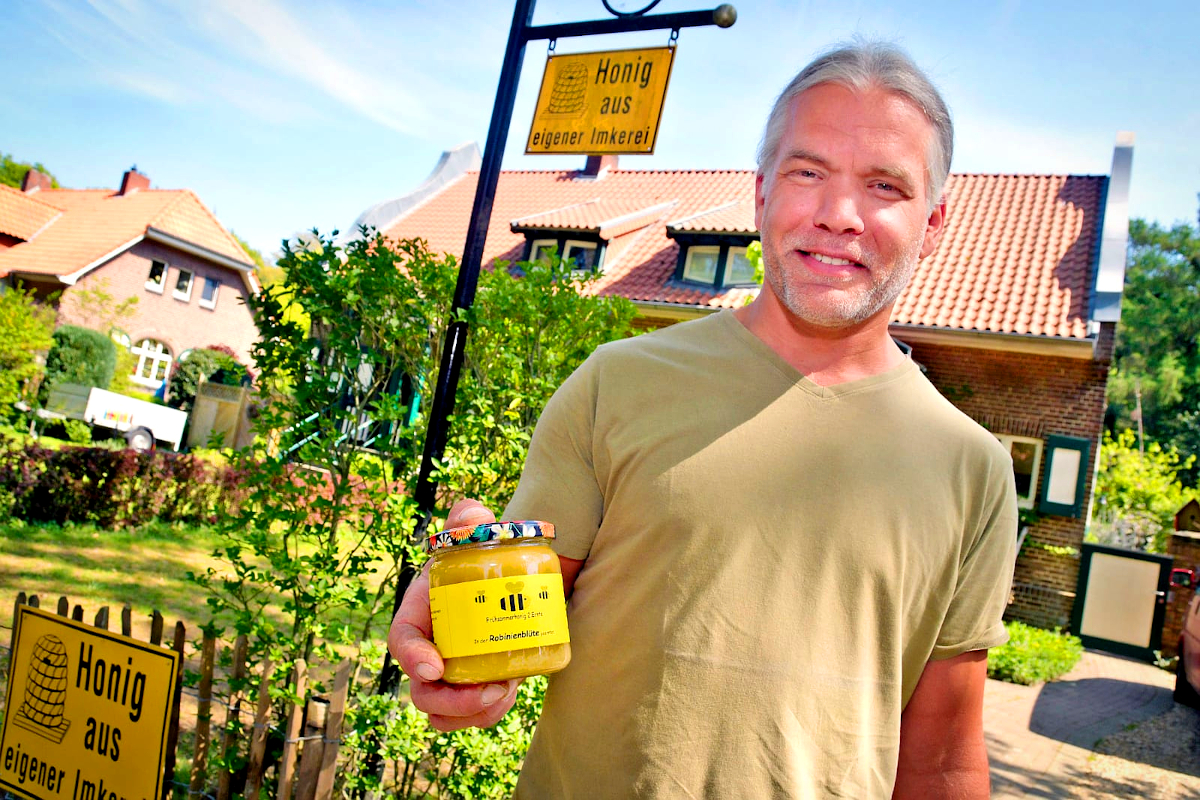
The interview took place on 17.01.24 at Rhine-Waal University of Applied Sciences in Kleve.
Marco is a beekeeper from Bedburg-Hau on the Lower Rhine who produces excellent regional honey and other bee products. You can buy his products directly from his home at Horionstraße 50 or at regional markets.
Aspermühle: Who are you?
Marco Janßen: I'm Marco Janßen and I'm a hobby beekeeper.
Aspermühle: How or why did you get into beekeeping?
Marco Janßen : I got into beekeeping myself through a lecture given by 2 master beekeepers, Udo Baumgärtner and Thomas Radetzki, in Lahnstein in 2007. At the time, they pointed out that bees were dying and that beekeeping was outdated, so they decided to train beekeepers and I signed up and bought some bees straight away because I was so fascinated by it.
My interest in saving bees was therefore paramount. I also really like honey.
Aspermühle: How long have you been beekeeping?
Marco Janßen: Since 2008.
Aspermühle: Is beekeeping your main job?
Marco Janßen : I'm actually a carpenter.
Aspermühle: Could you imagine being a full-time beekeeper and how many bee colonies would you need to make a living from it?
Marco Janßen: I could also imagine being a professional beekeeper, but that's not possible at the moment because you need a lot of space and a location with lots of flowers and, of course, significantly more colonies - up to 300. And it's also an intrusion into your life. You need a family to have your back. But I have already reduced my working hours in order to have enough time for beekeeping.
Aspermühle: Do you also breed queens?
Marco Janßen: That's not my philosophy. I actually want to work with the bees that live here by catching swarms. That's how I multiply my colonies.
Aspermühle: How many colonies do you have and what type(s) of bees do you have?
Marco Janßen: Currently 12 colonies of western honeybees.
Aspermühle: What does a bee colony actually consist of and how many bees are there per hive in summer and winter? Do you know them all by name?:)
Marco Janßen: There are different creatures in a beehive. There is a queen that is longer than all the other bees and lays 2,500 eggs a day in summer. That's an incredible achievement. In return, she doesn't have to worry about anything else and is fed and cared for by the workers. 300
drones in summer, these are the ones with the big eyes and they are also slightly larger than the workers. They can fly further, buzz louder, but have no sting. There are 30-60,000 workers. 10,000 in winter and up to 60,000 in summer, depending on the hive. Then the colony also consists of honeycombs, which are built from
wax that is sweated out by the bees, for which they have special glands. Within a week, the bees manage to build 3-4 combs that are large enough to survive the winter. There is about 1-2 kg of wax in a colony. Fresh wax is usually darker and darker over time due to propolis and pollen.
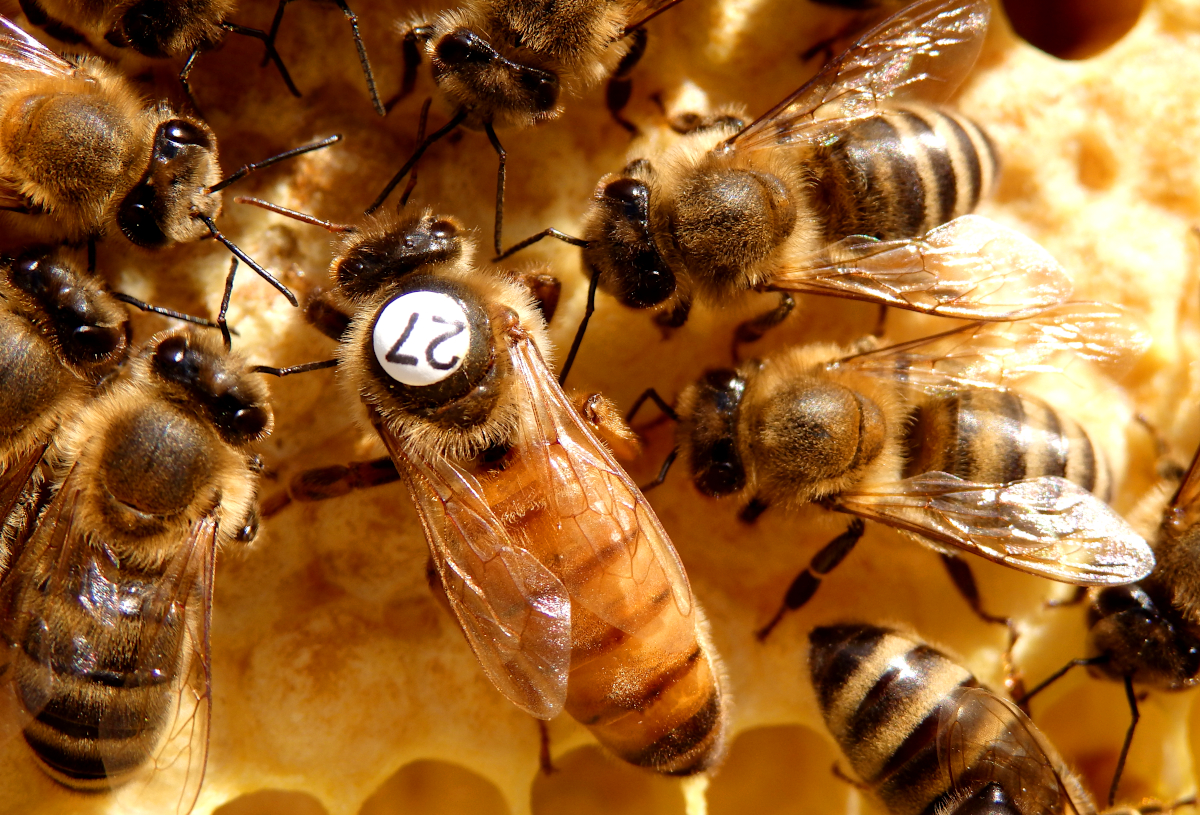
Queen bee between workers
Aspermühle: Where do you have your colonies and what should you consider when choosing a location? What do honey bees need?
Marco Janßen: They are at Horionstraße 50, in Bedburg Hau, in my garden. Honey bees need protection from the weather and enemies. Originally, bees lived in hollow trees or caves. Mainly because of the weather, but also because of bears and birds that want to eat the honey or larvae. Bees also need
pollen, i.e. pollen and putty resin. The putty resin from buds and trees is propolis, which is effective against bacteria, viruses and fungi. There is also a sufficient supply of nectar. A safe water source 20-30 meters away is optimal, but they would also fly further. They also need treatment against the Varroa mite.
Aspermühle: You don't hike with the bees either?
Marco Janßen: Exactly, I used to do that, but it's stressful for the bees. If you then go to an orchard, they are usually sprayed and I don't want to put my bees through that.
Aspermühle: And what does a beekeeper need?
Marco Janßen: Protective clothing, of course. This is not always needed, but if you are beekeeping on a day when the bees are in a bad mood, it would be bad not to have any. One of the most important tools is the
hive chisel, which looks like a small crowbar. This is needed to get the boxes and frames apart. It can also be used to scrape off wax and propolis. The following video explains the different types of hive chisels:
You also need a smoker, i.e. the beekeeper's pipe, which is also the most popular swear word for the beekeeper. :)
There are different models, with bellows or as a pipe. I prefer the smoker.
The smoke causes the bees to think that the forest is on fire and take up supplies instead of attacking.
A feather to sweep the bees from the comb without disturbing them too much. The advantage over the beekeeper's broom is that bees can get stuck in the broom.
Also beehives.
Of course, specialist knowledge and insurance cover, as there is always the possibility of storm or water damage or vandalism.
You also need space for the material and later a honey extractor and scales.
I use scales for honey filling to weigh the colony before winter and to determine whether the bees have enough food or need to be fed additionally. The bees should have their food in the colony by mid-September. Another scale to weigh the honey jars.
You need a wax melter because you should always melt the wax again for hygienic reasons to prevent wax moths from spreading.
You also need oxalic and formic acid, filling buckets and sugar for feeding.
Aspermühle: What obligations does the beekeeper have?
Marco Janßen: The number of colonies must be reported annually to the animal disease fund. If you are in an association, you will automatically receive a letter.
You also have to register with the district veterinary office.
Aspermühle: Where are you allowed to keep bees and what is an ideal bee location?
Marco Janßen: Actually anywhere where you don't disturb anyone, both in the countryside and in the city, for example on roofs. Of course, you should talk to the neighbors beforehand.
The apiary should be built for the beekeeper. If possible, the location should offer food in the surrounding area all year round, preferably within a radius of 0.5 km, otherwise you will have to go hiking with the bees. The water point should be available and not dry out, otherwise the bees will be stressed. Especially in dry and hot summers, as in recent years.
8 Aspermühle: How much time does beekeeping take?
Marco Janßen: You need about 1 hour per week per two colonies over the year. But of course there are peak times, for example the inspection periods from the end of April to July, when a little more time is needed. And the harvest takes a whole day. If I go to the bees in the morning and take down the honey chambers, free the frames from the bees and transport everything to the extractor room and then uncover and extract the frames and after extracting fill the honey into buckets and then of course clean everything, you are busy until 1-2 o'clock in the morning depending on the quantity.
Of course this refers purely to beekeeping. If you start from scratch, you first have to prepare the site and build the hives. But these are one-off jobs. After that you have years of peace and quiet.
In addition, you can't be away from your colonies for more than 7 days during the swarming period (end of April-beginning of July) if you want to prevent swarms.
You should also have fed by the middle of September. Then there are the 2 treatment dates. The first is after the second harvest, in early to mid-July after the lime blossom, with formic acid. This takes about 11 days, so you can go on vacation for 14 days. This must be done. And another oxalic acid treatment in mid-December.
Aspermühle: What work does beekeeping involve?
Marco Janßen: Regular inspection of the hives, especially during the swarming period.
Harvesting honey twice a year (after the rape or lime blossom), spinning, filling, cleaning the kitchen.
Treating the bees twice a year against varroa and winterizing (feeding) the bees.
Catching or preventing swarms.
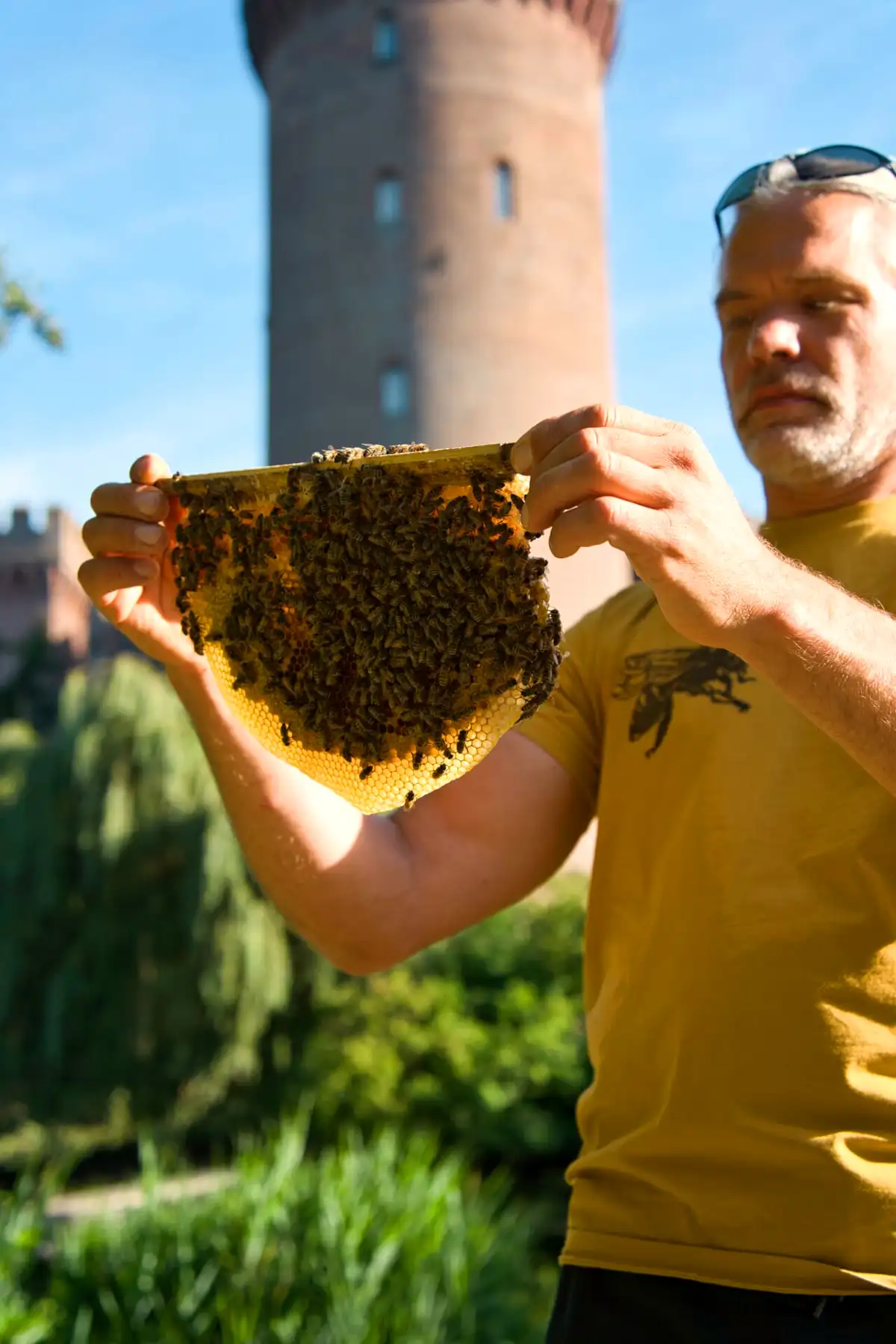
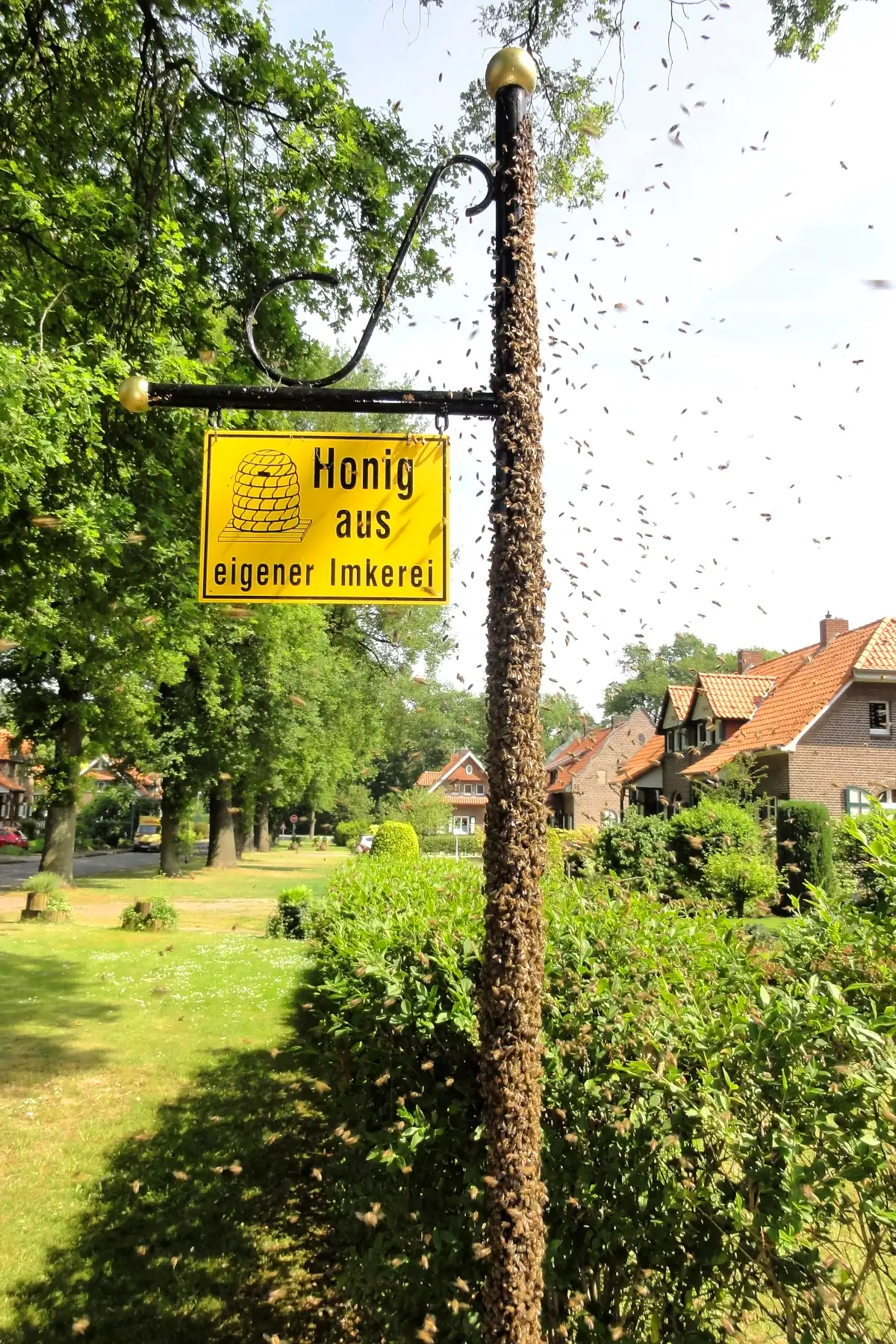
Aspermühle: How do you prevent a colony from swarming:
Marco Janßen: The best way is to break the queen cell, i.e. the cell in which the queen is raised.
This requires regular close monitoring. It may already be too late after a week.
The queen usually needs 16 days from egg to hatching. For 3 days the egg is an egg, then a larva and after the 9th day the cell is capped.
So from day 9, the old queen can leave with half of the swarm, especially if the weather is nice and it may have rained beforehand.
When the swarm leaves, it is as loud as if someone has turned on a turbine, but after half an hour all the bees are sitting together in a cluster.
Aspermühle: What bee products do you harvest and in what quantities? Do you also make other products from them and how do you sell them?
Marco Janßen: I actually only harvest wax and honey and some propolis.
For my own use I also harvest pollen and perga, i.e. the stored pollen, which is much easier to digest because you don't have to soak it in sour milk first. Perga is directly digestible.
Aspermühle: When is the honey harvested and how much honey do you get from a bee colony?
Marco Janßen: On the Lower Rhine twice a year, after the rape and lime blossom. You can harvest about 40-50 kg per colony. But this depends on various factors, the environment, the weather, the strength of the colony and the beekeeper's skill. It may be that the harvest fails and it may be that you get a bumper crop.
Aspermühle: What quality controls do you carry out? (Water content/pollutants)
Marco Janßen: I check the water content in the honey before and after harvesting and the honey is tested by the district health authority at irregular intervals and there have never been any complaints. They test for American foulbrood, foreign bodies and hygiene factors, for example. The label is also checked.
Aspermühle: Do you belong to a beekeepers' association?
Marco Janßen: Yes, the Kleve-Kellen beekeepers' association.
Aspermühle: Do you run a special type of beekeeping or which one would you recommend?
Marco Janßen: If you ask 10 different beekeepers, you will get 10 different answers.
I use Dadant hives, which are 51 cm square and belong to the large-capacity hives. They fit 12 frames. However, I only use 10 in winter and 6-8 in summer, which means that I have fewer frames to move during the inspection, which makes the inspection relatively quick, which is good for the bees. There is also only one brood chamber.
I also used Warré hives for a while, which are very minimalist but also very labor intensive.
There are also one-room hives, which are very back-friendly as you don't have to carry frames.
Then we also have the block hive, which is the oldest way of beekeeping in the garden. This came directly after the bees were cared for in the forest by the Zeidler, who then began to hollow out trees. Here the bees build in a natural way.
Then there is the German normal size, which I have also tried, but would not recommend, as it has a divided brood chamber and uses wider Hoffmann frames with a large support, which increases the risk of crushing bees, which I am not a fan of.
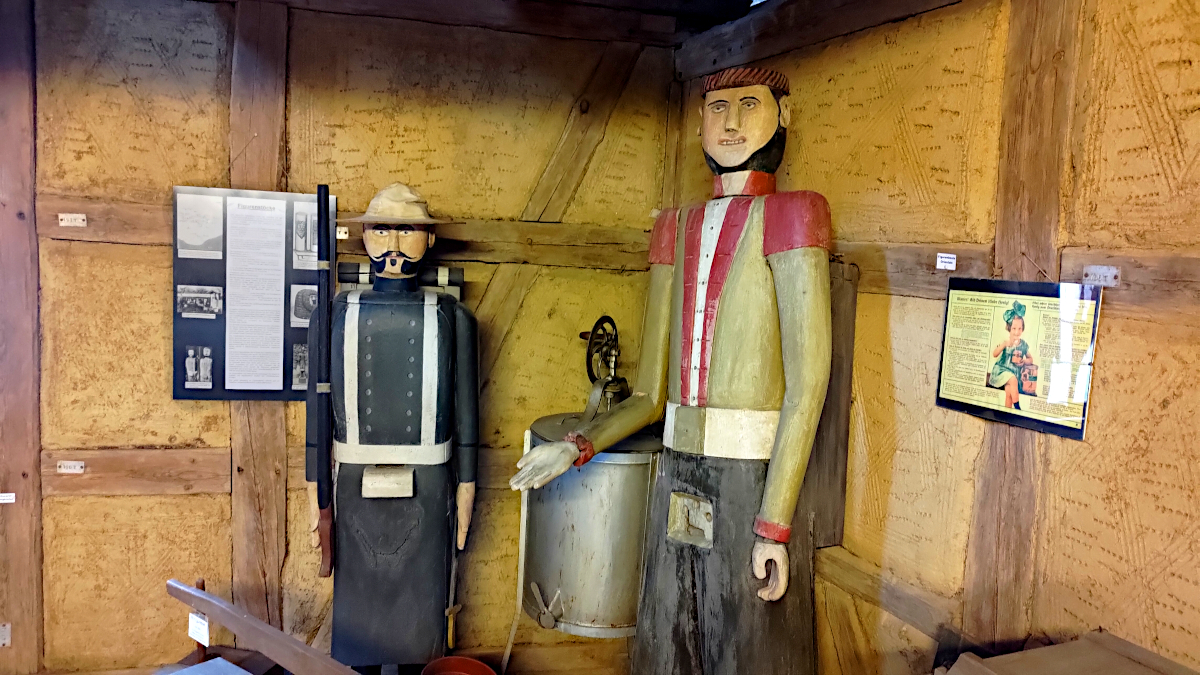
Block hives as figure hives in the Landwüst open-air museum
Aspermühle: What types of bees are there?
Marco Janßen: There are 9 different types of honeybees worldwide. In Germany, the western honey bee is generally used.
There are around 550 species of wild bees in this country and around 30,000 species worldwide, which are generally solitary bees and highly specialized. Our honey bees cover different types of flowers.
Aspermühle: Do you treat your bees against diseases? Against which ones and how?
Marco Janßen: I treat them against Varroa mites. This requires oxalic acid, which is used towards winter (December). Formic acid is used in the summer after the second harvest.
Aspermühle: How long has Varroa been around and where does it come from?
Marco Janßen: The Varroa mite comes from Asia, from the honey bee species Apis cerana.
The extremely rapid multiplication took place through the use of the Trans-Siberian Railway, as bee colonies were transported to Asia on this route, where the western honey bee spread via swarms and took the mite with it everywhere and of course also brought it back to Europe, Africa and America. The only continent that was not affected until recently was Australia. However, Varroa has now also been discovered there.
Aspermühle: Do you build your boxes/ frames yourself?
Marco Janßen :
I build natural honeycombs without wire and use frames with the smallest possible contact surface so that no bees are crushed.
Aspermühle: Are you certified organic?
Marco Janßen: Unfortunately not yet, but I do beekeeping according to the nature of the bees. I could get certified. The only thing I would have to change would be to adapt the feeding of the bees accordingly and feed them with organic sugar. But the husbandry is already appropriate
I don't use plastic hives, I don't clip the queens' wings and I don't have any intensive farming in the immediate vicinity.
So I could imagine it if it wasn't so expensive.
Aspermühle: Would it be realistic for the bees to look after themselves and you wouldn't have to feed them?
Marco Janßen: Depending on the location, it would be conceivable. There are good locations where you have to feed little or not at all. But that is always a risk. For example, if the colony weighs 35 kg and I would rather have 44 kg, then I also feed the missing kilos and don't say I don't feed them so as not to put sugar on my bees.
Of course, next spring, when everything is in bloom, I take the feed out again.
But mixing it with honey is out of the question anyway, as the sugar is in the brood chamber and I harvest from the honey chamber.
Another thing that worries many people is the issue of ragwort, as this is very poisonous.
However, this is not usually a problem, as ragwort usually only flowers when the harvest is already complete after the lime blossom. This could only become a problem where there are no lime trees.
Aspermühle: What can a private individual do to support bees?
Marco Janßen: Make the landscape bloom and plant appropriate flowering plants as food, for example by planting a meadow of flowers or fruit trees. Or early or late bloomers such as crocuses or bee trees. Buy honey from a beekeeper.
Aspermühle: Can you say something about insect mortality?
Marco Janßen: It's definitely a huge problem, not just for the insects, but also for us humans. If we no longer have insects as pollinators, then at some point there will be a tipping point and then we can expect other species, plants and mammals to die out too.
As long as there are enough beekeepers, the extinction of insects will not affect normal honey bees for the time being, as they look after the bees.
Aspermühle: How do you maintain a bee colony and how do you propagate bees?
Marco Janßen: I do it by propagating offspring or collecting swarms. I also recommend that everyone starts with a swarm.

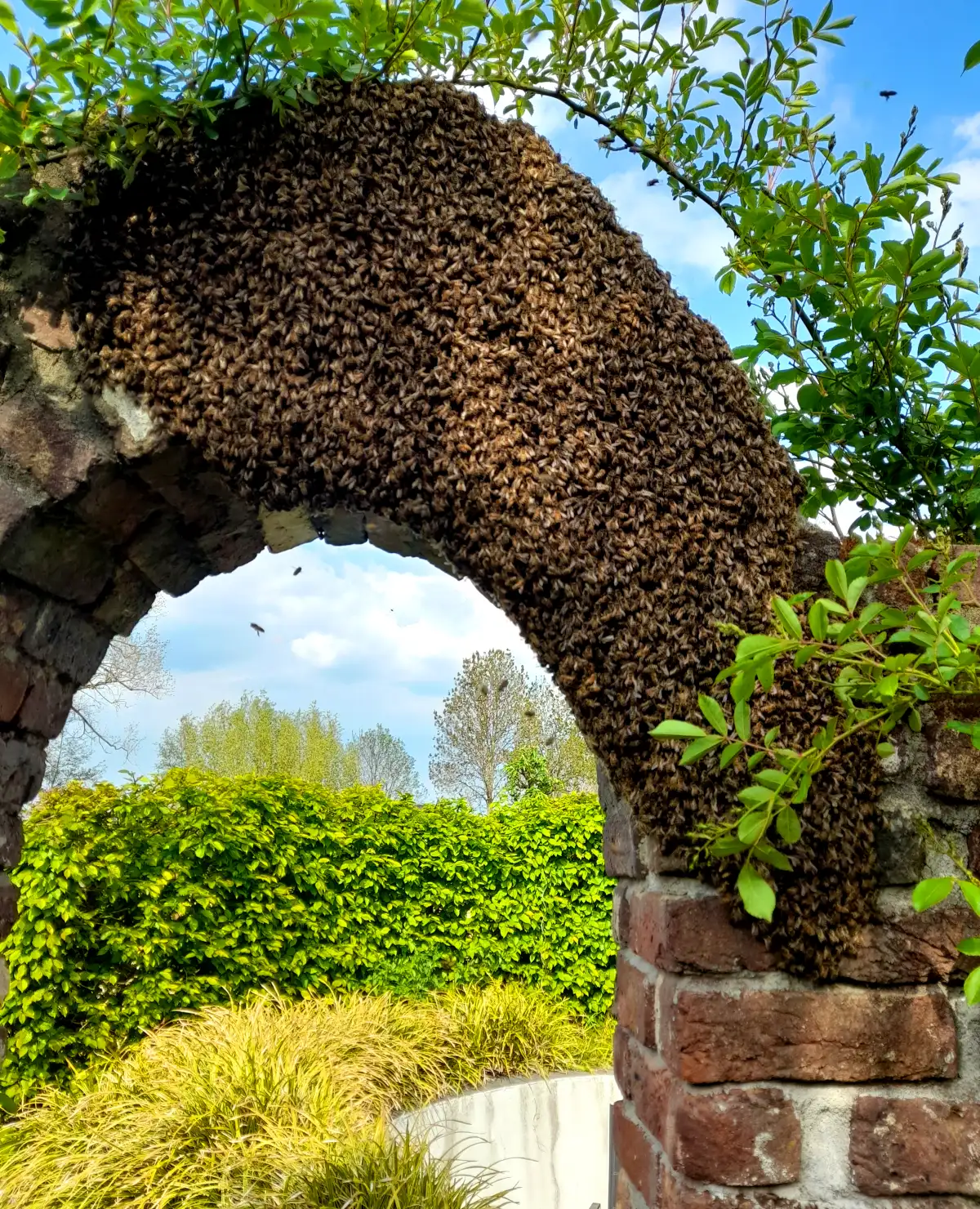
Aspermühle: What do bees do in winter and what work is involved?
Marco Janßen: Mainly tidying up and preparing frames. The bees use up their supplies. That's 20 kg that they need until March, 10 kg of which only in March, because the brood needs a lot in this month.
In winter, a Varroa treatment with oxalic acid is also carried out once in December.
Aspermühle: How is the treatment noticeable?
Marco Janßen: As a beekeeper, I notice it when you find lots of dead mites on the so-called diaper, the white plate under the combs, after the treatment.
Aspermühle: How often do you get stung? :) What do you do when you get stung?
Marco Janßen: Over time you get stung less, but it's still about 10 times a year. It always depends on what work you have to do. Sometimes the stings could have been avoided if you had behaved differently. Most of the time it's beekeeping mistakes or carelessness.
Well-intentioned advice: if you are stung, you should scrape the sting away (for example with a hive chisel) and not try to pull it out, because then you squeeze the venom blister and even more venom penetrates the skin.
Aspermühle: You hearin the media from time to timethat beehives are stolen. Have you ever had bee colonies stolen?
Marco Janßen: So far, neither I nor other beekeepers in the association have had any colonies stolen. But you read about it every year. You should therefore place the bees in a protected location and you can now also install a GPS tracker.
Aspermühle: Do you also have to deal with other insects?
Marco Janßen: Yes, the wasp season starts every year after the bee season and I get calls almost every day to relocate wasp nests. But also hornet and bumblebee nests. Anything that has settled somewhere that is a nuisance. I either advise or I relocate.
Aspermühle: Are bees dangerous for neighbors?
That depends on many factors.
Bees fly low when they collect water. Usually at head height. You should be aware of this, for example, if your neighbor has a pond, as it can cause a nuisance. It only becomes dangerous if you have an allergic reaction to a sting or if you are stung in an unfavorable place, such as the mouth.
Aspermühle: Do you "lend out" your hives for pollination?
Marco Janßen: I don't do that. The demand isn't there either and you don't get paid enough for the pollination service.
Aspermühle: How sustainable is beekeeping in terms of climate change?
Marco Janßen: Good question, but I don't know that either. You can expect to have more losses. The bees are very adaptable, but the extremes are certainly not healthy for the bees. There will be different problems in different regions. Especially in very dry areas where the bees don't find enough water.
Aspermühle: Beekeeping in the city is becoming more and more popular. What do you think of honey harvested in the city?
Marco Janßen: There is less spraying in the city, the trees are not sprayed at all. In the countryside, fruit trees in plantations are sprayed. However, greenwashing is also often practiced here.
For example, bee colonies are set up at airports and the honey is clean according to tests. However, the toxins tend to accumulate in the bees or in the wax and honey remains clean, even though there are kerosene residues at airports.
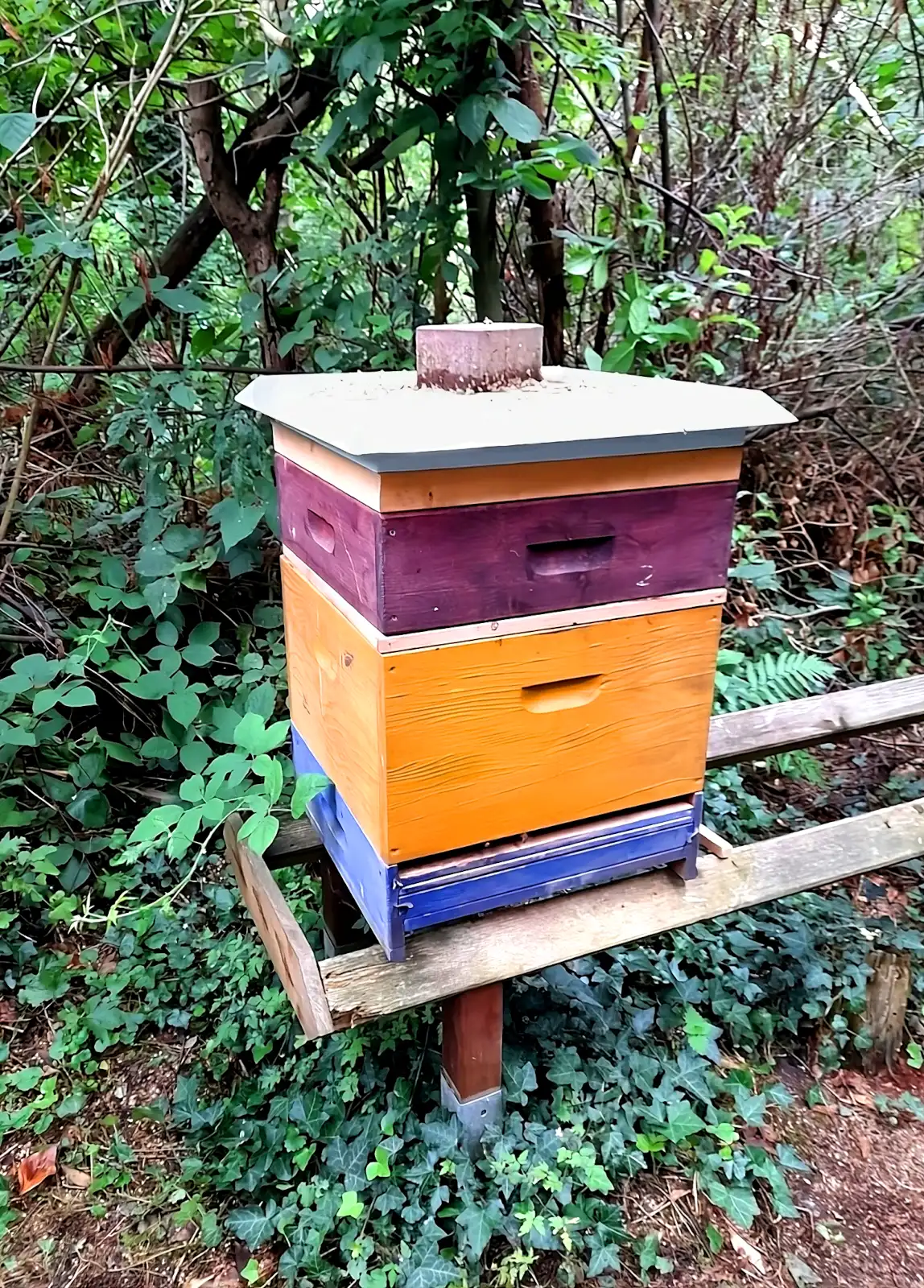

Aspermühle: Are your children also interested in beekeeping?
Marco Janßen: Of course they have supported me at times. They sometimes help with catching swarms or harvesting. But I don't see them becoming beekeepers themselves. But I was still too young at 20. You need a certain amount of peace and quiet and have to settle down, but they are still studying or in training.
I'd like them to do it.
Aspermühle: You were in the Philippines last year in your role as a beekeeper. What did you do there?
Marco Janßen: I supported a local beekeeping business in the start-up phase. Unfortunately, we introduced the western honey bee there. That was not my wish or my recommendation, but the wish of my client. The problem is that we were on a small island where there are very few western honey bees and only one other beekeeper, and here the queen bee has the problem that she can't find any drones when she makes her mating flight. And then there are also bee-eating birds called
bee-eaters, which may also catch the queen bee on her mating flight. So the biggest problem is a lack of mated queens.
Aspermühle: Why should they be introduced there at all?
Marco Janßen: Because they are thought to be more successful and better than the native bees, which is not the case. I also had my eye on the eastern honeybee (Apis cerana) or giant honeybees. These would have been better.